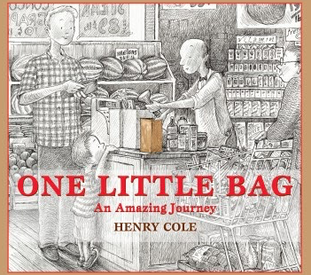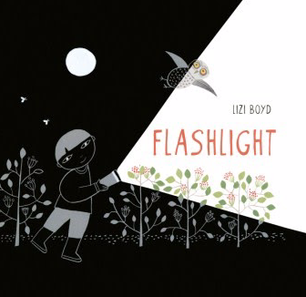There are many ways to incorporate this format into instruction. Language Arts lessons on sequencing or perspective-taking can feature Bill Thompson’s Chalk in younger grades, or Flotsam by David Wiesner in older grades. Discussions about empathy or resilience can be enhanced by Lee’s Pool or Miyares’s Float. Last year, while teaching 7th grade English, I used picture book art as prompts for grammar practice.

Wave by Suzy Lee
A girl’s encounter with the ocean is captured with vibrant charcoal and acrylic drawings that show beautifully to a story-time group. At first shy, the girl mimics the ocean’s roar, boldly dances at the water’s edge, and finally is caught by a giant wave which deposits treasure in the form of shells. The perspective, with its strong horizon line, stays constant, emphasizing the movement of the waves, the seagulls, and our exuberant heroine. Be sure to compare the beginning and final endpapers.

Flotsam by David Wiesner
A boy’s day at the beach turns extraordinary when he discovers an old-fashioned camera, a very different kind of ocean treasure. Panels packed with details advance the plot and illustrate an other-worldly underwater environment that has been documented by other children through the years.

Pool by JiHyeon Lee
Also a story of magical underwater discovery, Pool highlights the theme of friendship. A raucous group of swimmers, depicted in unflattering black and white tones, fades away as a boy and girl meet under the water. The color palette expands as they, too, discover whimsical creatures and emerge as friends. Recommended for reading with groups of older students where the concepts of shallowness and depth can be explored in large or small group discussions.

Journey by Aaron Becker
The dull city gives way to an enticing river after a bored young girl, perhaps taking inspiration from Harold and his crayon, draws a door and steps through it. Double-page spreads and shifting perspectives are used to full advantage and immerse the reader in the escalating drama. The satisfying home-away-home framework is heightened by a surprise twist, foreshadowed on the title page. The wordless adventures continue in Quest and Return.

Float by Daniel Miyares
A paper boat, made from a newspaper page, is the source of possibility and heartbreak for a little boy on a rainy day. Clad in a bright yellow raincoat, he stands out against the muted backdrop of clouds and neighborhood. The strong left-to-right movement in the double-page spreads propels the story forward to its climax, followed by at-home comfort and a sun-washed finale. Directions for folding a paper boat and paper airplane are included on the endpapers, an ideal post-reading activity.

One Little Bag: An Amazing Journey by Henry Cole
In this gentle limited-palette story, the focus is on family and sustainability. Beginning with the first endpaper, the visual prologue shows the process of paper bag manufacturing, from forest to grocery store. The bag, highlighted in medium brown and decorated with a heart from Dad, is then used for a boy’s school lunch. Delicate pen-and-ink drawings in spot sequences and panels show the boy growing up, always re-using the same bag. Hearts are added to the bag as he becomes first a husband, then a father. Finally, the bag returns to the earth, encircling a pine sapling as it is planted in a clearing.

Flashlight by Lizi Boyd
Against a nighttime background of black and silver, a child explores the woods. The flashlight beam illuminates all manner of flora and fauna, rendered in delicate gouache hues. Small die-cuts create additional focal points. In a whimsical turnabout, several animals take possession of the flashlight and heighten the fun. Best for sharing with small groups, as there are a myriad of details to pore over and to question.

Red Hat by Lita Judge
A group of curious backyard animals discover a red hat, and a rollicking adventure ensues. Told through double-page spreads of lush watercolors, this is another excellent story-time choice. While technically not wordless (sound effects like “hiii-ya!” and “tink-a-tink” punctuate the pages), the action and emotion are brilliantly conveyed throughout, right down to the final mischievous endpaper.

Pip & Pup by Eugene Yelchin
Pip, a newly-hatched chick, spies a potential playmate across the barnyard. After several mini-dramas, including pecks, a chase scene, and a thunderstorm, the two form a firm friendship. Yelchin keeps the expressive pastel artwork close to the ground, immersing young readers in the animals’ world.

Another by Christian Robinson
Similar to Flashlight, this nighttime adventure starts with a bright, beckoning light and playful animals. A young girl follows a cat into a brightly lit, whimsical dimension. The upside-down perspective invites the viewer to rotate the book, and the bold collages and inventive use of space emphasize the other-worldy atmosphere.

Chalk by Bill Thompson
Three friends find some chalk at a playground and discover its magical power in another excellent read-aloud choice. Double-page spreads with hyper-realistic acrylic art show the characters’ emotions, while the perspective zooms upward as the tension rises.

Field Trip to the Moon by John Hare
Color is used to excellent effect in this space-based adventure. A space shuttle, in bright school-bus yellow, arrives to transport young space-suited students to the moon. Against deep black space and moon-grey craters, one student makes an amazing discovery and shares the power of creativity, using a box of crayons.


